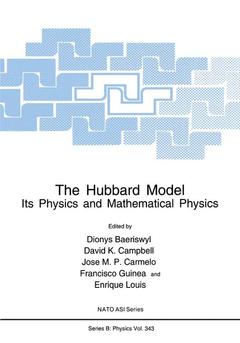The Hubbard Model, Softcover reprint of the original 1st ed. 1995 Its Physics and Mathematical Physics NATO Science Series B: Series, Vol. 343
Langue : Anglais
Coordonnateurs : Baeriswyl Dionys, Campbell David K., Carmelo Jose M.P., Guinea Francisco, Louis Enrique

In the slightly more than thirty years since its formulation, the Hubbard model has become a central component of modern many-body physics. It provides a paradigm for strongly correlated, interacting electronic systems and offers insights not only into the general underlying mathematical structure of many-body systems but also into the experimental behavior of many novel electronic materials. In condensed matter physics, the Hubbard model represents the simplest theoret ical framework for describing interacting electrons in a crystal lattice. Containing only two explicit parameters - the ratio ("Ujt") between the Coulomb repulsion and the kinetic energy of the electrons, and the filling (p) of the available electronic band - and one implicit parameter - the structure of the underlying lattice - it appears nonetheless capable of capturing behavior ranging from metallic to insulating and from magnetism to superconductivity. Introduced originally as a model of magnetism of transition met als, the Hubbard model has seen a spectacular recent renaissance in connection with possible applications to high-Tc superconductivity, for which particular emphasis has been placed on the phase diagram of the two-dimensional variant of the model. In mathematical physics, the Hubbard model has also had an essential role. The solution by Lieb and Wu of the one-dimensional Hubbard model by Bethe Ansatz provided the stimulus for a broad and continuing effort to study "solvable" many-body models. In higher dimensions, there have been important but isolated exact results (e. g. , N agoaka's Theorem).
Introduction. Solvable Models, Rigorous Results, and Advances in Formalism: The Hubbard Model: Some Rigorous Results and Open Problems; E.H. Lieb. On the Bethe Ansatz Soluble Degenerate Hubbard Model; H. Frahm, A. Schadschneider. Infinite in all Dimensions: Large Coupling, High Dimensions, Many Components: The Mott Transition in Infinite Dimensions: Old Ideas and Some Surprises; G. KIotliar, M.J. Rozenberg. The Hubbard Model with Infinite Interaction: Magnetic Properties; V.Ya. Krivnov, et al. Fermi Liquid versus Luttinger Liquid: Two Particle Scattering and Orthogonality Catastrophe in the Hubbard Model; W. Metzner. Conservation Laws in Normal Metals: Luttinger Liquid vs. Fermi Liquid C. Di Castro, et al. Perturbative, Mean Field, Variational, and Numerical Studies: Hartree-Fock and RPA Studies of the Hubbard Model; G. Guinea, et al. The Wavefunction Renormalization Constant for the One- and Two-band Hubbard Hamiltonians in Two Dimensions; E. Louis, et al. Experiments and Physical Applications: Electron Spectroscopy and Hubbard: Issues and Opportunities; J.W. Allen, et al. On Electrical Properties of Chalcogenide Glassy Semiconductors in the Framework of Hubbard Model with Negative Correlation Energy; S.D. Savransky. 34 additional articles. Index.
Date de parution : 06-2013
Ouvrage de 407 p.
17.8x25.4 cm
Disponible chez l'éditeur (délai d'approvisionnement : 15 jours).
Prix indicatif 210,99 €
Ajouter au panierMots-clés :
© 2024 LAVOISIER S.A.S.



